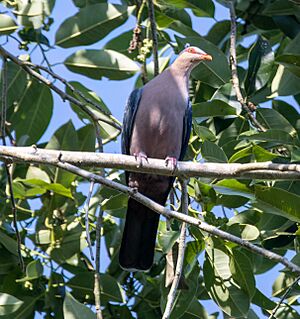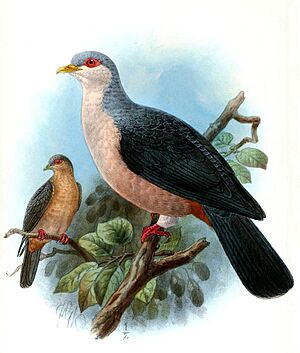Seram mountain pigeon facts for kids
Quick facts for kids Seram mountain pigeon |
|
|---|---|
 |
|
| Conservation status | |
| Scientific classification | |
| Genus: |
Gymnophaps
|
| Species: |
stalkeri
|
 |
|
| Synonyms | |
|
|
The Seram mountain pigeon (Gymnophaps stalkeri) is a special type of bird. It belongs to the pigeon family. This pigeon lives only on Seram Island in Indonesia. It likes to live in the island's hill forests.
This pigeon is medium-sized. It has a buff-pink face and chest. Its belly is a wine-pink color. The back of its neck and head are grey. Its lower belly and tail underside are dark chestnut.
Seram mountain pigeons eat fruit. They often fly and feed in groups. These groups can have up to 50 birds. Scientists have found only one nest so far. It had one egg inside. The nest was in an old mountain forest.
This pigeon is listed as "least concern" by a group called the International Union for Conservation of Nature (IUCN). This means its population is stable. It also has a large enough area to live in.
Contents
What is the Seram Mountain Pigeon?
The Seram mountain pigeon was first described in 1911. A Scottish bird expert, William Ogilvie-Grant, named it Columba stalkeri. He studied birds from the Kanobi Mountains on Seram Island.
Later, in 1927, an Australian bird expert named Gregory Mathews grouped it with the Buru mountain pigeon. They were placed in the Gymnophaps family. But in 2007, two scientists, Frank Rheindt and Robert Hutchinson, decided it was a separate species. They saw differences in how the birds looked.
The name Gymnophaps comes from old Greek words. Gumnos means bare, and phaps means pigeon. The name stalkeri honors Wilfred Stalker. He was an Australian collector who found the first birds of this species. The official name for this bird is Seram mountain pigeon.
The Seram mountain pigeon is one of four types of mountain pigeons. They all belong to the Gymnophaps group. These pigeons live in areas like Melanesia and the Maluku Islands.
What Does the Seram Mountain Pigeon Look Like?
The Seram mountain pigeon is a medium-sized bird. It is about 33 to 38.5 centimeters (13 to 15 inches) long. It weighs about 330 to 338 grams (11.6 to 11.9 ounces).
It has a deep buff-pink face and chest. Its chin is a lighter pink. The rest of its belly is a wine-pink color. Its upper legs are grey. The back of its neck and head are a pale blue-grey. The lower part of its belly and the underside of its tail are dark chestnut. These feathers have wine-grey edges.
The pigeon's eyes are scarlet to yellow. The skin around its eyes is purplish red to scarlet. Its beak is yellow with a purple area near its face. Its legs are purple. Young pigeons look a bit different. They have browner upper parts and bellies. Their tail undersides are darker. Their eye skin and legs are dull red. Their beak is grey with a white tip.
Where Do Seram Mountain Pigeons Live?
The Seram mountain pigeon lives only on Seram Island. This island is part of the Maluku Islands in Indonesia.
These pigeons mostly live in hill forests. They are found at heights of 400 to 2,300 meters (1,300 to 7,500 feet). They are usually more common above 1,200 meters (3,900 feet). However, some have been seen as low as 100 meters (330 feet).
How Do Seram Mountain Pigeons Behave?
These birds are very social. They are often seen in groups of more than 20 birds. They eat fruit. When they look for food, their groups can be even larger. Some groups have up to 50 pigeons.
Breeding and Life Cycle
Scientists have seen the Seram mountain pigeon doing a special flight in February. This flight is like a display. It is similar to what Papuan mountain pigeons do. Male Papuan pigeons fly up high from a branch. Then they drop down fast and return to their spot.
The Seram mountain pigeon's display flight is a bit different. It is lower and not as steep. After dropping down, it keeps flying forward instead of going right back to its branch.
The only known nest was found in September. It was in an old mountain forest. The nest was about 2,300 meters (7,500 feet) high. It was placed in a crack on a dead, mossy branch. The branch was 2.5 meters (8.2 feet) above the ground. The nest was loosely made with twigs and moss. It held one single white egg.
What is the Seram Mountain Pigeon's Status?
The Seram mountain pigeon is listed as a "least concern" species. This is according to the International Union for Conservation of Nature (IUCN). This means it is not in danger of disappearing. Its population seems stable. Also, it has a large enough area to live in.
We don't know the exact number of these pigeons. But they are thought to be more common than the Buru mountain pigeon. They are especially common at heights of 1,300 to 1,700 meters (4,300 to 5,600 feet).
Images for kids





